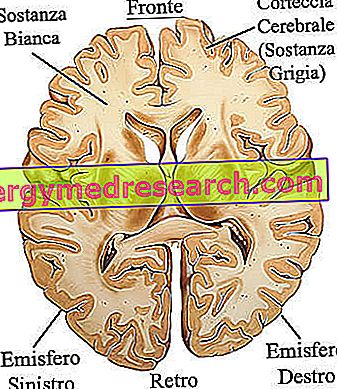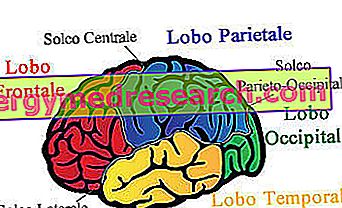Generality
The frontal lobe is the large area of the cerebral cortex, which constitutes the anterior portion of each hemisphere of the human brain.

Protected by the frontal bone (which forms the anterior region of the cranial vault), the frontal lobe is bordered by the parietal lobe (postero-superiorly), the temporal lobe (postero-laterally), the orbital cavity and the floor of the anterior cranial fossa (inferiorly).
Home to several important functional areas of the brain (including the area of Broca and the primary motor cortex), the frontal lobe plays a key role in the control of voluntary movements, in the production of spoken and written language, in the peculiarities of the character, in the long-term memory, in attention management, in planning capacity, in the planning of behaviors and actions associated with the so-called reward system and in the ability to classify objects.
Brief anatomical review of the brain
The brain is, together with the spinal cord, one of the two fundamental components of the central nervous system .
Heavy about 1.4 kilograms and containing 100 trillion neurons (in the adult human being), the encephalon is a very complex structure, which can be divided into 4 large regions, which are: the brain proper (or telencephalus or , simply, brain ), the cerebellum, the diencephalon and the brainstem .
BRAIN PROPERLY SAID
The brain is the largest and most important region of the brain.
Its general anatomical shape requires the presence of:

- Two large specular hemispheres (the right cerebral hemisphere and the left cerebral hemisphere ), separated by a groove (the so-called interhemispheric groove ), and
- A corpus callosum, located at the base of the two aforementioned cerebral hemispheres.
On the surface, the brain has the so-called gray substance, which goes to make up a laminar layer called the cerebral cortex ; in the deeper layers (therefore below the surface), instead, it presents the so-called white substance .
What is the Frontal Lobe?
The frontal lobe is one of the four large areas (called lobes ), in which the cerebral cortex of each hemisphere of the human brain is ideally divided; to be precise, of the four lobes of the brain that form each cerebral hemisphere, the frontal lobe is the anterior one (it is, in fact, anterior to all the other cerebral lobes).
The frontal lobe can be defined as an "even zone" of the telencephalon, where "even" means that it is present both on the right cerebral hemisphere ( right frontal lobe ) and on the left cerebral hemisphere ( left frontal lobe ).
What are the other lobes of the brain?
In addition to the frontal lobe, each cerebral hemisphere also includes the temporal lobe, the parietal lobe and the occipital lobe .
Of the cerebral cortex, the first constitutes the latero-inferior area, the second the upper area and the third the posterior area.
Anatomy
Protected by the frontal bone of the skull, the frontal lobe develops posteriorly to the area of the head indicated by the term "forehead"; this explains the use of the adjective "frontal".
Representing about 41% of the total volume of human cerebral cortex, the frontal lobe holds the primacy of the largest lobe of the human brain (after him, there is the temporal lobe). Furthermore, it is distinguished by being the area of the cerebral cortex with the largest quantity of dopamine-sensitive neurons (which - as the reader will later be able to ascertain - play a decisive role in its functional capabilities).
Location and boundaries of the Frontal Lobe
Included in the so-called anterior cranial fossa, the frontal lobe is bordered by:
- The parietal lobe, posteriorly,
- The temporal lobe, posterolateral,
- The orbital cavities and the so-called anterior cranial fossa floor, below,

- The frontal bone, anteriorly and superiorly, e
- A small portion of parietal bone, above.
To separate the frontal lobe from the parietal lobe and the temporal lobe, as if they were boundary lines, are the so-called central sulcus (or Rolando's sulcus ) and the so - called lateral fissure of Silvio (or fissure silviana or lateral fissure ). Both the central groove and the lateral fissure of Silvio are grooves characterized by a certain depth.
Subdivisions of the Frontal Lobe
According to the most traditional of anatomical descriptions of the frontal lobe, the latter is divisible into 3 surfaces, whose names are lateral surface, medial surface and lower surface, and in a pole, called frontal pole .
Before proceeding with the description of every single surface of the frontal lobe, it is appropriate to review the neurological concepts of convolution and sulcus :
- The convolutions are sections of cerebral cortex similar to crests, between two depressions of variable depth.
- The grooves are the depressions of variable depth just mentioned, ie the separation elements of each convolution.
SIDE SURFACE
The lateral surface is the portion of the frontal lobe closest to the inner walls of the frontal bone; in other words, of the frontal lobe, the lateral surface is the layer of cerebral cortex closest to the frontal bone.
The lateral surface includes 4 convolutions and 3 grooves; the 4 convolutions are called: superior frontal convolution, middle frontal convolution, inferior frontal convolution and precentral convolution ; the 3 furrows, instead, take the name of: superior frontal furrow, inferior frontal furrow and precentral groove .
Upper frontal convolution: runs parallel to and in the immediate vicinity of the interhemispherical groove. This convolution is called superior, because it is in effect the highest part of the lateral surface.
Medium frontal convolution: running parallel to the upper frontal convolution, on the lateral (ie external) side of the latter.
The boundaries of this convolution are marked by the superior frontal furrow (border with the superior frontal convolution) and the inferior frontal furrow (border with the inferior frontal convolution).
Lower frontal convolution: it is parallel and lateral to the average frontal convolution; to mark the border with the latter is the inferior frontal furrow.
Precentral convolution: it runs, more or less, in a perpendicular direction with respect to the three previous convolutions, placing itself at the boundary with the parietal lobe, exactly between the precentral groove and the Rolando groove.
MEDIUM SURFACE
The medial surface is the portion of the frontal lobe closest to the corpus callosum; in a sense, the medial surface is the innermost portion of the frontal lobe.
The medial surface is very complex, because it includes various elements of a certain relevance, including: the medial frontal convolution, the cingulate convolution, the rostral convolution, the paracentral lobule, the septal area and the cingulate sulcus .
Among the various elements of the medial surface of the frontal lobe, the cingulate gyrus deserves special mention, since the latter contributes to the formation of the so-called limbic system . The limbic system is a collection of brain structures, which play a key role in emotional reactions, short-term memory processes, behavior and smell.
LOWER SURFACE
The lower surface is the portion of the frontal lobe representing the floor of the latter; in other words, the lower surface is the base of the frontal lobe.
Bordering the basal segment of the lateral fissure of Silvio, the lower surface includes 5 convolutions and 2 grooves. The convolutions are: the right convolution, the anterior orbital convolution, the posterior orbital convolution, the medial orbital convolution and the lateral orbital convolution ; the furrows, on the other hand, are: the olfactory sulcus (between the straight convolution and the group of orbital convolutions) and the orbital sulcus (straddling the anterior and posterior orbital convolutions and the medial and lateral orbital convolutions).
Did you know that ...
Of the 3 surfaces that form the frontal lobe, the lower surface is the smaller, preceded in order by the medial surface and the upper surface.
FRONT POLE
The frontal pole is one of the 3 so-called cerebral poles (the other two are the occipital pole and the temporal pole) and corresponds to the characteristic roundness present in the most advanced point of the frontal lobe.
Functional areas of the Frontal Lobe
Some important functional areas of the brain are located on the frontal lobe; these functional areas are:
- The primary motor cortex . It takes its place on the precentral gyrus and includes most of the cells of origin of the descending path, that is the motor nerve pathway which serves to initiate voluntary movements.
- The premotor cortex and the supplementary motor area . They occupy the remaining part of the precentral gyrus, the superior frontal convolution and the average frontal convolution, and carry out a supporting action against the aforementioned primary motor cortex (therefore they are involved in voluntary movements).

- The area of Broca . It is based on the inferior frontal convolution and plays a fundamental role in the production of spoken and written language.
- The prefrontal cortex . Constitutes the regions of the frontal lobe that are not primary motor cortex, premotor cortex, supplementary motor area and Broca area.
The prefrontal cortex plays a key role in so-called executive functions, which include: the creation of strategies, planning, emotional control, attention, concentration, self-control of impulses and so on.
Blood supply of the Frontal Lobe
The inflow of oxygenated blood to the frontal lobe, which is essential for keeping the latter alive, depends on two branches of the internal carotid artery, which are: the anterior cerebral artery and the middle cerebral artery .
Development
Medical studies have shown that the frontal lobe reaches full developmental maturity around the age of 20 and that, with old age (starting from about 60 years), it is the victim of a process of atrophy so to speak inevitable.
Function
The frontal lobe participates in very important functions, such as:
- Control of voluntary movements .
In everyday life: the frontal lobe supports the coordination of voluntary movements, allowing the execution of motor activities such as walking, running etc.
- Long-term memory .
It should be noted that the long-term memory capacity is not the prerogative of the frontal lobe, but depends on different brain areas (for example also on the temporal lobe).
In everyday life: this function of the frontal lobe allows the human being to formulate and preserve the so-called long-term memories.

- The production of spoken and written language .
As already mentioned, this function belongs to the area of Broca, present on the upper surface of the frontal lobe.
In everyday life: the frontal lobe is the brain area that allows you to translate thoughts into words, a fundamental process for communication.
- The ability to understand and react to the feelings of others .
In everyday life: the understanding of and the reaction to the feelings of others are the basis of the so-called empathy, or the ability to understand and put oneself in the shoes of others.
- The choice of behaviors from the perspective of the so-called reward system and the ability to imagine the consequences deriving from a certain action and / or decision.
These functions are closely related to the large presence, in the frontal lobe, of dopamine-sensitive neurons.
In everyday life: the frontal lobe guides the behaviors that should lead to a certain result, to achieve something gratifying, to feel better, etc.
- Attention management, including selective attention.
In everyday life: an individual's ability to pay attention to what is happening around him and to maintain a certain degree of attention depends on this function.
- The ability to classify objects .
In everyday life: this function makes it possible to distinguish one object from another, a process only apparently trivial.
- The personality .
In everyday life: the frontal lobe strongly influences the way of being and the peculiarities of the character of each individual.
The Frontal Lobe is not an autonomous organ
Just like all the other cerebral lobes, the frontal lobe is a nervous structure whose functioning is strictly dependent on the interaction with the other encephalic components (including the other lobes of the brain); this means that it is not an autonomous organ, but one of the various components of that complex "machine" called encephalon.
Did you know that ...
The correct functioning of an area of the brain also depends on the correct functioning of the other brain regions with which the aforementioned area is related.
Thus, it is possible that the frontal lobe is malfunctioning due to the malfunctioning of a brain area connected to it.
diseases
The frontal lobe can lose one or more of its functions, when it suffers an injury or is the subject of an event that alters its normal anatomy.
To deteriorate the functions of the frontal lobe can be: strong trauma to the head in frontal, episodes of stroke at the level of the frontal lobe (NB: the stroke is the phenomenon of interruption of blood supply to a brain area, followed by necrosis of the latter due to lack of oxygen), brain tumors located on the frontal lobe and some particular medical conditions, such as the known Alzheimer's disease, frontotemporal dementia and the so-called frontal lobe epilepsy .
Symptoms of lesions and anatomical alterations of the Frontal Lobe
The lesions and anatomical alterations of the frontal lobe produce different symptoms, depending on which functional area they affect (eg: a lesion against the Broca area triggers different effects from a lesion affecting the primary motor cortex) and depending on their extension (ex: the lesion of the frontal lobe of a single cerebral hemisphere is responsible for problems different from the lesion of the frontal lobe of both cerebral hemispheres).
Having clarified this very important aspect, the typical manifestations of an lesion or anatomical alteration of the frontal lobe are:
- Poor coordination of voluntary movements;
- Problems in the production of spoken and written language, without however impairing comprehension (expressive aphasia or Broca's aphasia);
- Difficulty in impulse control;
- Change of personality;
- Difficulty in planning strategies, judgments, behaviors or actions with a certain purpose, etc .;
- Abulia (that is, loss of will);
- Intellectual deficits;
- Apathy and lack of empathic capacity;
- Loss of the front visual field;
- Foster-Kennedy syndrome (set of symptoms, such as anosmia, ipsilateral optic atrophy and contralateral papilledema);
- Confabulation.
Curiosity: what is frontotemporal dementia
Belonging to the great category of dementias, frontotemporal dementia is a neurodegenerative disorder of the brain, which appears due to the progressive deterioration of neurons located in the frontal lobes and in the temporal lobes of the brain.
Those suffering from frontotemporal dementia develop behavioral and language problems, inability to think, memory impairment (amnesia), balance disorders and reduced control of some body muscles; in other words, it is a victim of disorders related to the simultaneous dysfunction of the frontal lobe and temporal lobe.



